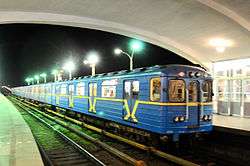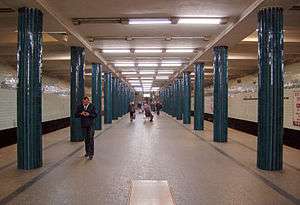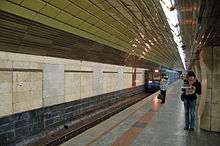Kiev Metro
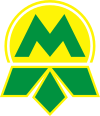 | |
|
A type Ema-502/Ezh train at Dnipro station | |
| Overview | |
|---|---|
| Native name |
Київський метрополітен Kyivs'kyi metropoliten |
| Owner | Kiev City Council |
| Locale | Kiev |
| Transit type | Rapid transit |
| Number of lines | 3[1][2] |
| Number of stations | 52[1][2] |
| Daily ridership | 1.439 million (2012)[3] |
| Annual ridership | 536.2 million (2013)[2] |
| Website | Kiev Metro (Ukrainian) |
| Operation | |
| Began operation | 6 November 1960 |
| Operator(s) | Kyivskyi Metropoliten |
| Number of vehicles | 794 cars[2] (in 150 trains) |
| Technical | |
| System length | 67.6 km (42.0 mi)[1][2] |
| Track gauge | 1,520 mm (4 ft 11 27⁄32 in) |
The Kiev Metro (Ukrainian: Київський метрополітен) is a metro system that is the mainstay of Kiev's public transport. It was the first rapid transit system in Ukraine and the third one built in the Soviet Union (after Moscow and St Petersburg Metros). It now has three lines with a total length of 67.65 kilometers (42.04 mi) and 52 stations.[1][2] The system carries 1.439 million passengers daily,[3] accounting for 38% of Kiev's public transport load. In 2013, the metro carried 536.2 million passengers.[2] One of the deepest stations in the world, Arsenalna (at 105.5 m or 346 ft), is found on the system.[4]
History

The story of a rapid transit system in Kiev begins in 1916 when businessmen of the Russo-American trading corporation attempted to collect funds to sponsor construction of a metro in Kiev, which previously has been a pioneering city for Imperial Russian rapid transit, like opening of the first Russian tram system. After the downfall of the Tsarist government Hetman Skoropadsky was also much interested in building the system, but after the downfall of the Hetmanate in the autumn of 1918 Ukraine plunged into chaos of Occupation by Communist Russia and the project was shelved for good.
Following the Bolsheviks' victory in the Russian Civil War, Kiev became only a provincial city and no large-scale proposals to improve the city were drawn. Two decades later all this changed when in 1934, the capital of the Ukrainian SSR was moved from Kharkiv to Kiev. On July 9, 1936, the Presidium of the Kyiv City Council looked at a project by Papazov (Papazian), an Armenian graduate of the Moscow University of Transport Engineering, called, "The Project of the Kyiv Metro." The meeting minutes stated that, "the author successfully resolved one of the problems of reconstruction of the city of Kyiv and establishment of intra-city transportation and also answered various practical questions pertaining to the Metro plan." The engineer Papazov (Papazian) received a bonus of 1000 rubles for this project from the City of Kyiv.[5]
Following the terrible destruction suffered by the city in the war, a massive reconstruction was opened for the capital of the third largest city in the USSR. This time the Metro was in the plan and construction began in August 1949. Eleven years later the first 5.2 kilometers (3.2 mi) segment from the Vokzalna to Dnipro was opened.
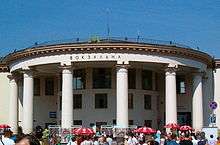
Those five stations formed the central part of what is today known as the Sviatoshynsko-Brovarska Line, which runs from the west to the east of the city. The line crossed the Dnieper river in 1965 across a newly constructed Metro Bridge and went east to the large residential areas being built on the left bank of the river, with subsequent extensions in 1968 and 1971. At the same time it extended to Kiev's westernmost residential areas of Sviatoshyn and Bilychi in three stages 1963, 1971 and 2003.
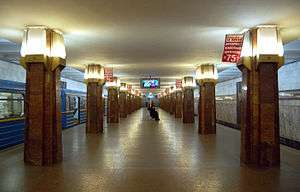
Construction of the second line began in the early 1970s and the first three stations were opened in 1976. What became known as the Kurenivsko-Chervonoarmiyska Line continued expanding. In two stages (in 1980 and 1982) it reached Obolon, then the largest residential district, in northern Kiev. At the same time construction continued to the southwest with new stations added in 1981-84.
Construction of the third, Syretsko-Pecherska Line began in 1981 for the first three station segment to open in 1989 in central Kiev. Following a northwest-southeast axis, in 1991 it continued up to the left bank of the Dnieper and by 1992 crossed the river and continued into the rapidly developing Poznyaky and Kharkivskyi residential districts which it reached in 1994. In mid late 1990s construction began on expansion to the older Syrets district in the northwest direction with stations opening in 1996, 2000 and 2004. In addition some of the intermediate stations were deliberately left unfinished and opened later: Pecherska (Opened in 1997) and Vyrlytsia (in 2006).
On December 15, 2010 three new stations (Demiivska, Holosiivska, and Vasylkivska) were opened in the direction of Teremki. On December 27, 2010 new station Vystavkovyi Tsentr was opened near the National Expocentre of Ukraine. Subsequent extension is not announced, but will include two branches with five stations in total.
Lines and stations
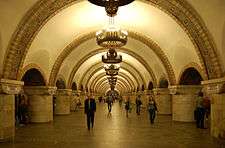
The metro follows a standard Soviet triangle three line, six radii layout that intersects in the centre where the stations are built very deep underground and could potentially double as bomb shelters.
There are now 52 stations.[2] The former comprise 20 stations, of which 17 are of pylon type, 3 are of column type. Of the 26 sub-surface stations, 13 stations are of pillar-trispan type, two are side-platform pillar bi-spans, 8 more are single-vaults, and a further one is an asymmetrical double deck bispan. In addition, 6 stations are located above ground, of which four are surface level, and two are flyover. Most of the stations have large vestibules, some on surface level whilst others are underground interlinked with subways. Access for disabled persons, previously overlooked, has become an important issue, and all new stations have been constructed with necessary provisions.
Three depots provide a total of 794 metro cars[2] which form 150 trains that travel on the 67.6 kilometers (42.0 mi)[2] of route operating between 6:00 and 0:00 which is when the metro is open.
Lines

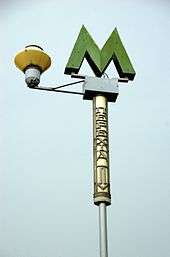
| Livery and # | Name | Name in Ukrainian Cyrillic | Date of first station opening | Most recent station opening | Length (km) | Number of stations | Ride time (end stn. to end stn.) |
|---|---|---|---|---|---|---|---|
| Line 1 (Sviatoshynsko-Brovarska) |
Лінія 1 (Святошинсько-Броварська) |
6 November 1960 | 24 May 2003 | 22.65 | 18 | 40 minutes | |
| Line 2 (Kurenivsko-Chervonoarmiyska) |
Лінія 2 (Куренівсько-Червоноармійська) |
17 December 1976 | 6 November 2013 | 20.95 | 18 | 31 minutes | |
| Line 3 (Syretsko-Pecherska) |
Лінія 3 (Сирецько-Печерська) |
31 December 1989 | 23 May 2008 | 23.9 | 16 | 44 minutes | |
| Total: | 67.6 | 52 | |||||
| Line 4 (Podilsko-Vyhurivska) |
Лінія 4 (Подільсько-Вигурівська) |
Under construction (Planned opening: after 2017) | ca. 20 (full line) | 15 (planned) |
n/a | ||
| Line 5 (Livoberezhna) |
Лінія 5 (Лівобережна) |
Planned | ca. 5 (first phase) | 17 (planned) |
n/a | ||
Line 1 (Sviatoshynsko-Brovarska)
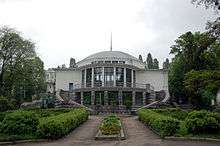
The Sviatoshynsko-Brovarska Line, is the first line of the Kiev Metro, dating back to 1960. It includes some of the system's more historically significant stations, like Arsenalna, which at 105.5 meters is the deepest in the world,[4] and the next station Dnipro, which although the tunnel follows a descent, appears above ground level.
All of the stations on the eastern bank of the Dnieper river are either ground or above ground level, this attributed to a similar experiment like Moscow's Filyovskaya Line however the warmer Ukrainian climate prevented the stations there from being severely deteriorated, which was why extensions in 1968 and 1979 were kept from going underground. The five original stations managed to survive Nikita Khrushchev's struggle with decorative "extras". The line's colour on maps is red.
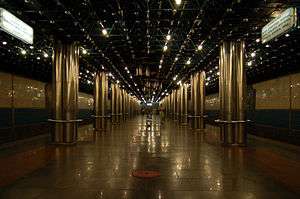
Line 2 (Kurenivsko-Chervonoarmiyska)
The Kurenivsko-Chervonoarmiyska Line, is the second line of the Kiev Metro, first opened in 1976, it extended northwards along the right bank of the Dnieper river and began deviating from the river towards the southwest. As the current stations were built in the 1970s and 1980s, architecturally the line shows some of the best examples of late-Soviet architectural features. It is coloured blue on maps.
Line 3 (Syretsko-Pecherska)
The Syretsko-Pecherska Line is the third line of the Kiev Metro, first opened in 1989. It extends the metro system southeast along the right bank of the Dnieper River before crossing it on a covered bridge and then east from there. The northern section extends further northwestwards. The line is one of the newest and shows some post-independence decorative motifs. Technically, it is also a great development, with most of the platforms longer and wider than older sections and with some stations having provision for disabled access. This line is coloured green on maps.
Construction and plans
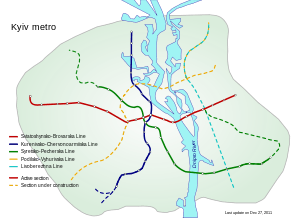
Plans for the Kiev Metro aim to nearly double its length by 2030-35. Several projects are underway:
- Construction of Line 4 (Podilsko-Vyhurivska). The fourth line of the Kiev Metro will connect the northern Troieschyna districts of the left bank with the future business centre of Rybalskiy Island on the Dnieper River, from there it will continue into the Podil region. This is the stage that is under construction as the river crossing is essential and will be, like in two previous cases, both automobile and Metro. However the line will continue eastwards along the northern slope of the Starokyivska Hora and into the northwestern part of central Kiev, where it will turn south and reach the Kiev Passenger Railway Station. In doing so it will offer transfers to all three other Metro lines and thus relieve the over-congested transfer points in the centre. The Podilskiy radius is the last planned stage which will bring the line to Kiev's Zhuliany airport and the residential districts on the way there. It is thought that this project the first part of it to open after 2017 and the line will finish construction by 2025.
- Extension of Line 3 (Syretsko-Pecherska) to Darnytsia will begin from the existing station of Boryspilska and turn by nearly 90 degrees northwestwards toward the Darnytsia Railway Station connecting the residential area in between, construction is to finish by 2020, but is suspended due to suspension of construction of Darnitskiy Vokzal.
- Extension of Line 3 (Syretsko-Pecherska) to Vynohradar is a three station extension to the Vynohradar district in north western Kiev. It is approved and should be completed by 2015-20.
- Construction of Line 5 (Livoberezhna). The northern end of the fifth line of the system exists already as part of the Kiev tram, however it will require conversion and will be temporarily operated by the Podilsko-Vyhurivska Line as a branch. Eventually a southwards extension will commence that will follow along the left bank of the Dnieper to Southern Osokorky district, this will be the last project in the Metro that is envisioned in the present expansion plan and is not expected to be completed until the end of the 2030s. It is planned that the first stage of this line will be launched in 2019.[6]
If all of this is completed the Metro will rise from the present 50 stations to approximately 100, which will include several ghost stations on the Syretsko-Pecherska Line. In the more distant future it is expected that rapid transit will be developed further including a surface ring railway which will go around Kiev and a rapid rail exchange with Boryspil Airport.
Architecture
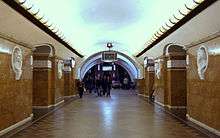
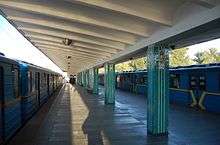
Like all Metro systems in the former Soviet Union which are known for their vivid and colourful decorations, Kiev's is no exception. The original stations of the first stage are elaborately decorated, showing the postwar Stalinist architecture blended with traditional Ukrainian motifs. Many first projects for stations offered at the beginning of the 1950s were full of rich decorative elements such as mosaics, ornaments, bas-reliefs, sculptures and a lot of marble. Each station was to have its own original shape. This stations were to be constructed in a monumental style like those stations built throughout the 1950s in Moscow and Leningrad. For example, Arsenalna station, instead of a small central hall, should have had a wide hall with sculptures of warriors of the civil and great patriotic wars; Vokzalna station was to be decorated with ornaments and bas-reliefs on columns and a big decorative map of the Ukrainian SSR, whilst Politeckhnichniy Institut station had, on its first project drawings, large mosaic panels depicting elements relating to the natural sciences.
By the end of the 1950s, a period of functionality and struggle against architectural extravagances had begun in Soviet architecture; this, propagated by Khruschev resulted in the loss of many unique projects, with the resulting stations being finished less the greater part of their decorations. Universytet station was, however, the subject of much less simplification than many others, retaining its many pylons adorned with the busts of famous scientists and writers. The next stations that opened in 1963 had an ascetic and strict appearance. Open-air stations, that opened in the 1960s and later the underground stations of 1971 were built to a standard primitive project, the so-called "sorokonozhka" (centipede); a name which came about due to the many thin supports to be found on both sides of the platform. Functionality became the most important factor in newer designs, and stations built at that time were almost identical in appearance, save the design of tile patterns and pillar covering material. Only in the 1970s did decorative architecture start to make a recovery. The stations built from the 1980s onwards show more innovative design when compared with stations of the same era in other cities of the former USSR.
Also, some of the older stations have undergone upgrades to lighting and renovation of some decorative material. After the declaration of Ukrainian independence following the dissolution of the Soviet Union in 1991, some of the Soviet symbols originally incorporated into decor were adapted to modern times or removed altogether by altering the architectural composition of those stations. All these Soviet symbols are due to be removed due to 2015 decommunization laws.[7]
New stations
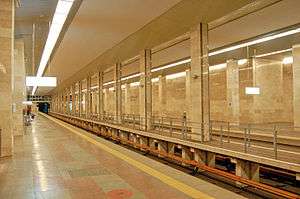 Chervony Khutir (2008)
Chervony Khutir (2008)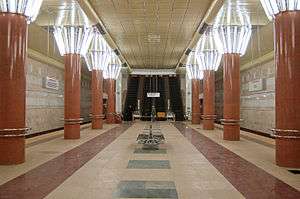 Demiivska (2010)
Demiivska (2010)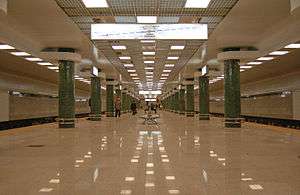 Holosiivska (2010)
Holosiivska (2010) Vasylkivska (2010)
Vasylkivska (2010)- Vystavkovyi Tsentr (2011)
- Ipodrom (2012)
- Teremky (2013)
Language issues
The use of Russian and Ukrainian languages in the Kiev metro can be taken as a good illustration of the linguistic policies of the Soviet Union and Ukraine. When the Metro was opened in 1960, although many workers and all technical level documents were using Russian, nevertheless all the signs and announcements used Ukrainian exclusively. The closeness of the languages did allow for every station to have a Russian translation and these were often given in Russian language literature and media. However some Ukrainian names for stations were different from Russian ones, and to signify this, those stations were semi-translated into Russian, effectively blending Ukrainian words into Russian grammar. Examples of this include Zhovtneva and Chervonoarmiyska (later renamed to Beresteiska and Palats Ukrayina respectively) which when translated into Russian would become Oktyabrskaya and Krasnoarmeiskaya. The names were instead given as Zhovtnevaya and Chervonoarmeiskaya. (If the semi-translation continued today, Chervony Khutir, which when translated into Russian would become Krasnyi Khutor, would be instead given as Chervony Khutor)
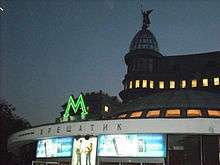
During the 1980s, partly due to Shcherbytsky's gradual Russification campaign, and partly due to Kiev becoming increasingly Russophone, the metro started to change as well. Although the stations retained their original Ukrainian titles on the vestibules, Russian appeared together with Ukrainian on the walls, and replaced Ukrainian in signs and voice announcements. Stations that were opened during this period still had Ukrainian names appearing along with Russian ones on the walls, but now all the decorations, where slogans were included, became bilingual as well. Also during this time, the unique practice of blending Ukrainian into Russian was dropped, and those selected stations were named in standard Russian translation.
During Perestroika in the late 1980s, bilingualism was gradually introduced in signs and in voice announcements in the trains. Prior to 1991, this was done with Ukrainian following Russian, but after the republic's proclamation of independence in August 1991 the order was changed to Ukrainian preceding Russian. After the fall of the Soviet Union in late 1991, both signs and voice announcements were changed from bilingualism to just Ukrainian due to the Ukrainianization policy. However, the Russian names are still used in Russian-language literature and some documentation, and some of the decorations still feature bilingual inscriptions.
Most older signs that featured Latin transliteration of Ukrainian names along with English titles such as "transfer to" or "exit" have been replaced with new ones. Most of these were in a separate, paler font. Some tram cars have monitors that indicate the next station, which alternate in Ukrainian and English, and in some places English translations have been added below the Ukrainian original.
Operation
Rolling stock
At the moment of its opening, the Kiev Metro's only line was served by Type D stock acquired specifically for its use. To begin with there were 24 full train sets in operation, however, from 1963 this figure rose to 39. In 1969 the type D trains were transferred to the Leningrad Metro and 39 newer type E sets were acquired to replace them.
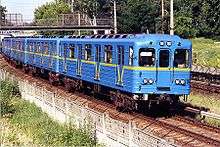
Train lift
Until the opening of the Darnytsia depot on 5 November 1965 the metro did not have any junction with Ukraine's main railway network. The cost of a tunnel which was to link the metro with the regular railways at Kiev Passenger Railway Station was found to be prohibitively expensive, and so it was with this in mind that the option of building an interchange at Darnytsia and a temporary depot at Dnipro station was considered.
Carriages were brought to the Darnytsia Railway Station, after which they were transferred onto tramlines which crossed the Dnieper River by way of the Paton Bridge, finally arriving at a railhead beneath the Dnipro metro station.
Under the Dnipro metro station train sections were rotated through 90 degrees by means of a turntable, and then lifted to the station's level by way of a specially constructed crane. This process was repeated (carriage by carriage) continuously until a full train set had been assembled aside the platform at Dnipro station and could proceed onwards to service in the metro. The same process was, in fact, then used in reverse every time a carriage on train set had to be returned to the depot for repair or maintenance work. The temporary Dnipro depot was located to the left of the similarly named station's vestibule, and was intended for the simultaneous servicing of no more than two carriages at a time.[8]
Current rolling stock
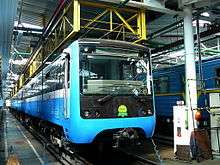
At the end of 2010 the Kiev Metro was using 774 individual carriages,[9] distributed as such:
- Line 1 (Sviatoshynsko-Brovarska) — 288
- Line 2 (Kurenivsko-Chervonoarmiyska) — 222
- Line 3 (Syretsko-Pecherska) — 242
There are three generations of train set in use by the Kiev Metro:
- Type E, E-zh, Em-501 and Ema-502. Such carriages are in use on the Sviatoshynsko-Brovarska (1) line. 251 carriages of this generation having been in service for more than 31 years - the typical operational life of a metro carriage.
- 81-717/714 series carriages. In use on all lines.
- 81-7021/7022 series Ukrainian-built carriages. In use on the Syretsko-Pecherska (3) line.
There is one 5-car set of the experimental 'Slavutych' Type 81-553.1 built in 2001. It was decided no further trains of this series will be built and was the 81-7021/7022 series will be ordered instead. The experimental 81-553.1 train is still operated on the Kurenivsko-Chervonoarmiyska (2) line between 7-10 AM weekdays.
In 2013 new trains were introduced to the metro.[10] Most of the trains are fitted with an overhead video information system. This system provides visual information to passengers regarding the current and the next stations and transfer opportunities between lines. While the train is in transit between stations, the system displays advertising (both in video and ticker forms), city news, recreational video content, and local time.
Management
The Kiev Metro is managed by the city-owned municipal company Kyivsky Metropoliten (formally known as Kyivsky ordena Trudovogo krasnogo znameni Metropoliten imeni V.I. Lenina) which was transferred in the early 1990s from the Ministry of Transportation. The Metro employs several thousand workers in tunnel and track, station and rolling stock management. In addition to being state sponsored for operation, income comes from ticket sales and from advertisements (controlled by a daughter company Metroreklama) that are displayed in most stations. Metro lines are being constructed by Kyivmetrobud public company[11][12] which allocates segments of construction to individual brigades that are responsible for tunnel and station construction. Kyivmetrobud is directly funded by the profits of the Metro and from the city and state budgets. Most of the state funding comes from Kiev's municipality and additional subventions are received from the State budget directly.
In 2009 Kiev Metro (Kyivsky Metropoliten) saw a loss of 210 million Hryvnya, since the tariffs for passenger transportation did not cover costs.[13]
Fares

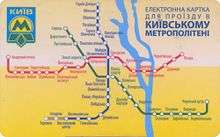
A single ride costs 4.00 hryvnia ($0.25) regardless of destination and number of transits within the metro. The ride is paid by plastic tokens and contactless cards when entering the metro.[14]
Plastic tokens are used for turnstiles; the tokens can be bought from cashiers at all stations or from automatic exchange machines that exchange 2 and 10 Hryvnia bills into tokens. The current tokens are of green color again; starts from 2008 till 2015 were used blue tokens.
Contactless (RFID-based, MIFARE[15] Classic and Ultralight) cards are also used to enter the metro. The card can be purchased for a small fee (7 hryvnias; refundable should one want to return the card) from cashiers and loaded for up to 50 trips with the same per-ride price as tokens. Also MasterCard PayPass cards can be used to enter the metro.[16]
The cards can be recharged either by a cashier, or by using a terminal. The terminals accept hryvnia paper bills in denominations of 1 to 50 UAH, and do not return change; instead they refill the card for the maximum possible number of rides given the sum of money deposited into the machine, and store the remainder in the system, to be used at next refill.
Also, the cards can be purchased for unlimited rides for a one or half month. A seven-minute second-use lockout is imposed for all unlimited cards to prevent abuse.
In the late 1990s - early 2000s (over a decade), monthly unlimited metro passes with a magnetic strip were used, before being phased out in favor of RFID cards, due to reliability and counterfeiting issues.
Originally the Metro ride cost 0.5 Soviet rubles (50 kopecks), however in 1961 following Soviet denomination, and for the next 30 years, the ride was fixed at 0.05 rubles (5 kopecks). Since 1991 as the country suffered from hyperinflation the price gradually rose by 1996 to 30,000 karbovanets. Following the 1996 denomination 30,000 karbovanets became 0.3 hryvnias (30 kopiyok). Since then the price was raised twice, to 50 kopiyok in 2000 and to 2 hryvnia in 2008. The price is set by the Kiev City Administration subject to approval of the national government. In November 2008 when the price was increased to 2 hryvnia, there were public protests and the Antitrust Committee of Ukraine ordered to decrease the price to 1.70 hryvnia as of January 23, 2009. In September 2010 the price was increased back to 2 hryvnia.
A proposal to set prices according to the distance traveled, or time spent in the metro, is being discussed. For this purpose, specially built "long" exit turnstiles with card readers at the far end have already been installed at some station exits.
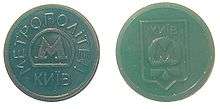

|
|
Quality
On the whole the condition of the metro is satisfactory for most people. For example, vandalism and graffiti are not common in Kiev Metro; vandalized trains are removed from service on sight and generally cleaned/re-painted within several days of the incident. Public order is maintained with police personnel on all stations and metro security staff at some stations and transfer points. All of the stations entry points are fitted with CCTV surveillance cameras, while some stations have all passenger-accessible areas covered.
Pickpocketing is a minor issue during rush hours, with Vokzal'na, Khreschatyk and Lybids'ka being the most affected stations.
The rolling stock is often repaired and renovated internally and externally. Newer models are being procured at the same time.
There are restrictions on the size of luggage that passengers are allowed to carry, and those that do are required to pay additional fees. Bicycles must be folded and/or have a wheel removed prior to entry; animals must be caged or leashed and muzzled.
Amateur photography is legal but is generally frowned upon by both the station personnel and police officers. Video shooting was illegal in the past but is now legal too.
Provisions for disabled people have been limited to ramps. However, the new stations are now fitted with elevators and plans are underway to upgrade the older stations as well.
See also
References
- 1 2 3 4 Про метрополітен [About the subway] (in Ukrainian). Київський метрополітен [Kiev Metro]. Retrieved 2015-08-01.
- 1 2 3 4 5 6 7 8 9 10 ОСНОВНЫЕ ТЕХНИКО-ЭКСПЛУАТАЦИОННЫЕ ХАРАКТЕРИСТИКИ МЕТРОПОЛИТЕНОВ ЗА 2013 ГОД. [Main technical and operational specifications for Subways for Year 2013.] (pdf). asmetro.ru (in Russian). Международная Ассоциация "Метро" [International Association of Metros]. 2013. pp. 1, 3. Retrieved 2014-05-13.
- 1 2 Kyiv General Department of Statistics, 2012
- 1 2 Арсенальна [Arsenalna] (in Ukrainian). Київський метрополітен [Kiev Metro]. 24 October 2008. Retrieved 2015-04-04.
- ↑ http://www.metropoliten.kiev.ua/hist.php?lang=2
- ↑ "Two companies rival to construct the first stage of Livoberezhna line of Kyiv's metro". Kyiv Post. 31 December 2009.
- ↑ (Ukrainian) From the dismantled in the Kiev subway communist symbols will be created a museum, Zerkalo Nedeli (8 May 2016)
- ↑ Загадки подземки на сайте «Интересный Киев»
- ↑ Рішення Київської міської ради від 30 грудня 2010 року № 574/5386 «Про Програму соціально-економічного розвитку м. Києва на 2011 рік» (in Ukrainian).
- ↑ Kyiv metro gets new station and trains, Railway Gazette International (27 August 2013)
- ↑ "Kievmetrobud official web site" (in Ukrainian). Archived from the original on June 10, 2012.
- ↑ Kyivmetrobud partner's site with correct naming of Ukrainian company Kyivmetrobud partner's site.
- ↑ "Kyiv Metropolitan sees Hr 210 million loss in 2009". Kyiv Post. 21 January 2010.
- ↑ Київський метрополітен [Київський метрополітен [Kiev Metro]] (in Ukrainian). Kiev Metro. Retrieved 2015-04-04.
- ↑ Что записано внутри бесконтактных карт Киевского метрополитена? (in Russian).
- ↑ Безконтактною карткою MasterCard PayPass у метро за проїзд можна сплатити на всіх станціях (in Ukrainian).
- ↑ "Tomorrow in Kiev, fares for passenger transport will double". Obozrevatel (in Russian). 6 February 2015. Retrieved 2015-02-09.
External links
| Wikimedia Commons has media related to Kiev Metro. |
- Kyivsky Metropoliten — Official website (Ukrainian)
- Kyiv metro on "Metroworld" page (English/Russian)
